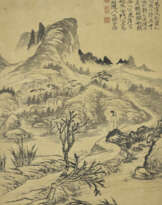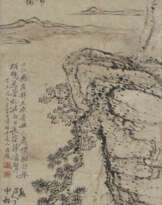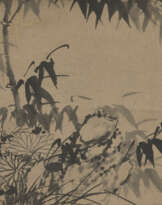ID 1086676
Lot 886 | SHITAO (1642-1707)
Valeur estimée
HKD 13 000 000 – 18 000 000
Yellow Peonies
Hanging scroll, ink and colour on paper
149.5 x 52.5 cm. (58 7⁄8 x 20 5⁄8 in.)
Inscribed and further inscribed, with a total of six seals of the artist
Three collector’s seals: one of Xu Maoxun (20th Century) and two of Xu Bangda (1911-2012)
Titleslip on the mounting
Titleslip by Wu Hufan (1894-1968), with one seal
Literature
Jin Yuan, Paintings and Calligraphy Records of Ten Hundreds Studio, Vol. IV, in Complete Compendium of Chinese Painting and Calligraphy, Vol. 7, Shanghai Painting and Calligraphy Publishing, Shanghai, October 1993, p.553.
Gu Wenbin, Paintings and Calligraphy of Guoyunlou, Vol. 5 Painting Section 5, in Selected Works on Classical Paintings and Calligraphy: Paintings and Calligraphy of Guoyunlou · Paintings and Calligraphy of Yuexuelou, Shanghai Rare Books Publishing, Shanghai, August 2011, pp.169-170.
Gu Wenbin, Gu Linshi, Combined Works on Paintings and Calligraphy of Guoyunlou, Vol. 9 Painting Section 5, in Jiangsu Literature Series: Combined Works on Paintings and Calligraphy of Guoyunlou, Jiangsu Rare Books Publishing, Nanjing, August 1999, pp.142-143.
Zheng Wei of Shanghai Museum ed., Shitao, Shanghai People’s Fine Art Publishing, Shanghai, May 1990, p.50.
Li Wancai, Research on Ming and Qing Masters Series: Shitao, Jilin Fine Art Publishing, Changchun, 1996, pp.267, 269, 291.
Wang Shiqing, Poetry by Shitao, Hebei Education Publishing House, Shijiazhuang, April 2006, p.150.
Zhang Heng, Zhang Congyu’s Dairy•Poetry Manuscript, Shanghai Paintings and Calligraphy Publishing House, July 2011, p.49.
Further details
Shitao’s Blossoms: Stories of the Shadow Garden and the Yellow Peonies
During the Ming Dynasty, hosting poetry and painting salons was a prevailing fashion amongst the Jiangnan literati. Located at the outskirts of Yangzhou, the distinguished Shadow Garden was the most prestigious venue for literati gathering. Of all the enchanting stories it had bred, those related to the Yellow Peonies Poetry Society were believed to be the most enduring.
The Shadow Garden was created by Zheng Yuanxun (1603-1644), a native of She county in Anhui province. Born to a prominent salt industry family, he passed the imperial examination in 1624 and in 1643, he achieved the title of jinshi (advanced scholar). In 1632 he presented the architectural blueprint of his garden construction to Dong Qichang, whom proposed to name it Shadow Garden, as it was surrounded by the shadows of willow, water and mountain. Directed by a renowned garden designer Ji Cheng, the construction commenced in the summer of 1634 and completed eight months later.
In 1640, Zheng invited his literati friends to appreciate the blossoming yellow peonies and chant poems in the Shadow Garden. A pair of delicate gold cups incised with ‘the best-appreciated yellow peony’ in the interiors were prepared to reward the poet laureate. Through the intellectual Mao Pijiang, Zheng invited the reputable Qian Qianyi to judge the contest. Eventually Li Suiqiu (1602-1646) won the championship with his ten poems In Praise of the Yellow Peonies in the Shadow Garden. It was a sensational event in Jiangnan.
Since the Qing Dynasty, this event had made a far-reaching impact, especially in the Canton area where Li was a native. Similar literati events were held in private gardens and until 1919, gatherings inspired by the Yellow Peonies Poetry Society still occurred.
Shitao’s Yellow Peonies was commissioned by the Holding Jar Master, with Li’s ten poems and the forementioned story inscribed in the upper portion of the painting. It was recorded in Paintings and Calligraphy Records of Ten Hundreds Studio and Paintings and Calligraphy of Guoyunlou written by Qing scholars Jin Yuan and Gu Wenbin respectively. According to The Diary of Chouyi by Wu Hufan, on 20 September 1938 he viewed two paintings including Yellow Peonies at the residence of Xu Bangda, and Xu regarded both as exceptional works. Besides, collector Zhang Congyu visited Xu Bangda on 4 October 1938 and Yellow Peonies was one of Xu’s recent acquisitions that displayed for him. He asked Xu, ‘The painting was commissioned by the Holding Jar Master. Isn’t he Jiangcun (Gao Shiqi) then?’ It was not a groundless assumption which requires further investigation. After 1967, Yellow Peonies was once in the collection of Shanghai Museum and published by the Shanghai Museum.
The repercussions of Yellow Peonies continued: inspired by Shitao’s masterpiece and the related poems composed in the Shadow Garden, Wang Shishen created his version of Yellow Peonies in 1728. In the universe where poetry and painting connect, chanting verses is just the prologue to graceful stories of noble peers!
| Artiste: | Shitao (1642 - 1707) |
|---|
| Artiste: | Shitao (1642 - 1707) |
|---|
| Adresse de l'enchère |
CHRISTIE'S 18 Chater Road Central Hong Kong Hong Kong | ||||||||||||||
|---|---|---|---|---|---|---|---|---|---|---|---|---|---|---|---|
| Aperçu |
| ||||||||||||||
| Téléphone | +85227601766 | ||||||||||||||
| Fax | +852 2760 1767 | ||||||||||||||
| Conditions d'utilisation | Conditions d'utilisation | ||||||||||||||
| Heures d'ouverture | Heures d'ouverture
|












